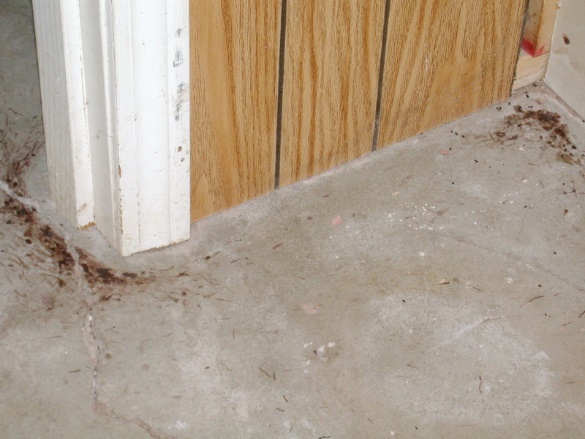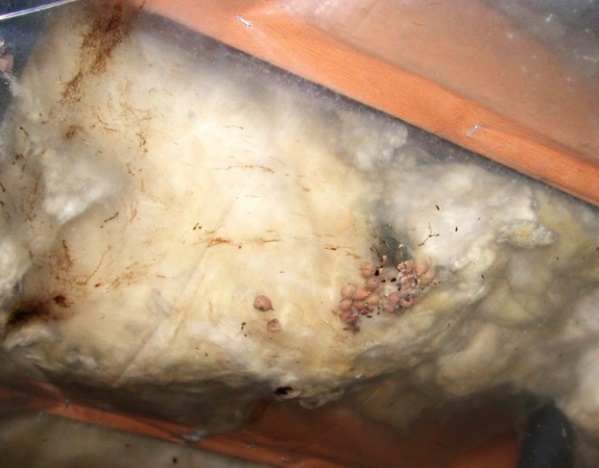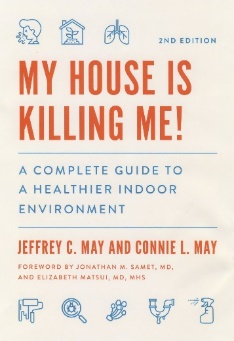Homeowner Newsletter, Winter 2024-2025
©2025 Jeffrey C. May
If you have allergies, asthma, or other environmental sensitivities and are considering moving into a new home, there are some building conditions that you should avoid:
A crawlspace or basement with a dirt floor. There are many older homes in New England, and some of them were built on basements or crawlspaces with exposed dirt “floors.” Moisture evaporates from exposed soil, increasing the relative humidity in a basement or crawlspace that contains exposed dirt. That moisture can fuel mold growth. Warm air rises, so in the heating season, hot air will rise and exit through windows and gaps at upper levels. Air also flows from higher pressure to lower pressure. As air flows out of a house, air must therefore flow back into the house. When the windows are closed (such as during the heating season), a lot of that “make-up” air flows up from a basement or below-grade (below ground level) crawlspace. That air can carry spores that occupants can inhale.
Many people say to me, “I never go into the basement, so I’m not worried about conditions down there.” Even if you never go into your basement or crawlspace, you could be inhaling mold spores that airflows from below-grade spaces are carrying upstairs.
A musty smelling, unfinished basement. Mold growth in a basement is not always visible, but trust your nose. If a basement smells musty, there is mold growth present, perhaps on stored goods or on an exposed foundation wall.
As air cools, its relative humidity (RH) rises. Some kinds of mold including allergenic Penicillium and Aspergillus species can flourish when the RH is over 80%: levels the RH can reach in air that is in contact with cool surfaces, like concrete or dirt below-grade. Below-grade spaces are naturally cool and damp and are thus prone to developing mold-growth problems.
Exposed fiberglass insulation in an unfinished basement or a crawlspace: Rodents just love to nest in this stuff, and there can be hidden mold in the material if the relative humidity has not always been adequately controlled. Building codes require that the habitable level of a house be isolated by insulation from an unfinished basement or a crawlspace. If fiberglass insulation is contaminated with mold growth or mouse detritus, the insulation should be removed under containment conditions and the exposed framing cleaned and sealed. I recommend that foundation walls be insulated with a foam product rather than having fiberglass insulation at the ceiling framing. Confer with a contractor about options.


A correlation has been drawn between exacerbated asthma symptoms and elevated levels of mouse-urine allergens indoors.
A finished basement with carpeting and/or a raised floor. I have rarely found carpeting in finished basements to be mold free. And a raised floor (flooring constructed on “sleepers,” and then a subfloor, so there is a “cavity” between the floor and the concrete) can hide all sorts of ills beneath – ills such as moisture intrusion and mold growth.
Carpeting in above-grade rooms as well as on stairs leading both upstairs and down into a basement. Carpet fibers capture biodegradable dust that can never be completely removed, even with the most thorough vacuuming. That dust could contain mold spores, pet-dander particles, bacteria clusters, microarthropod fecal pellets, and other allergens.
I often find that people will replace most carpeting that they “inherited” when they move into an new home but never remove the carpeting in hallways or on stairs: carpeting that may have received the most foot traffic in a house.
An air-handling unit (a furnace or central air-conditioner) that’s in the “wrong” place. If an air handler is contaminated with microbial growth that is located after the filter, the system can circulate byproducts of that growth into the indoor air that people inhale. An air handler that is tucked into attic eaves or positioned in a nearly inaccessible ceiling cavity or closet cannot be accessed easily for filter changes and other maintenance/cleaning as needed.
A home with jar candles and/or fragrance emitters. These can smell pleasant but mask all sort of worrisome odors. Be suspicious if you see many fragrance emitters in a home.
A home with a strong chemical smell. If the interior of a home was recently repainted or the wood floors were recently finished or refinished, solvents can off-gas for quite a while. Newly laid carpets can also off-gas potentially irritating chemicals. Anyone with chemical sensitivities should be cautious about moving into such a home until the affected rooms have been thoroughly ventilated with window box fans that blow air both in and out of the space(s). Oscillating fans can also be used to speed up evaporation of solvents from surfaces.
There is no way to know how long off-gassing will continue, so anyone with chemical sensitivities should be cautious about moving into a home with a strong odor.
“Trojan horses.” This is what I call furniture that is left behind by a prior occupant. Love to keep that comfortable couch? How about that solid wood dining-room set? Such pieces can contain allergens, so it’s best to ask the prior occupant to remove all personal goods from the home before you move in.
Refer to our latest book, Edition 2 of My House is Killing Me, for more guidance.
The book is available on line.

The photographs in this newsletter can be used with permission. jeff@mayindoorair.com
BOX OF NEWS
An interview with Jeff May and interviews with over 30 other professionals are included in the virtual summit “GOT MOLD?” that will launch February 20-23, 2025. For more information, go to: https://360summits.com/got-mold-summit/.
Connie May’s book A Parade of Drunks (a memoir of her childhood) will be published this February or March by the Onion River Press in Vermont and will be available on line.
May Indoor Air Investigations LLC, Tynsgborough, MA 01879
www.mayindoorair.com 978-649-1055 jeff@mayindoorair.com
